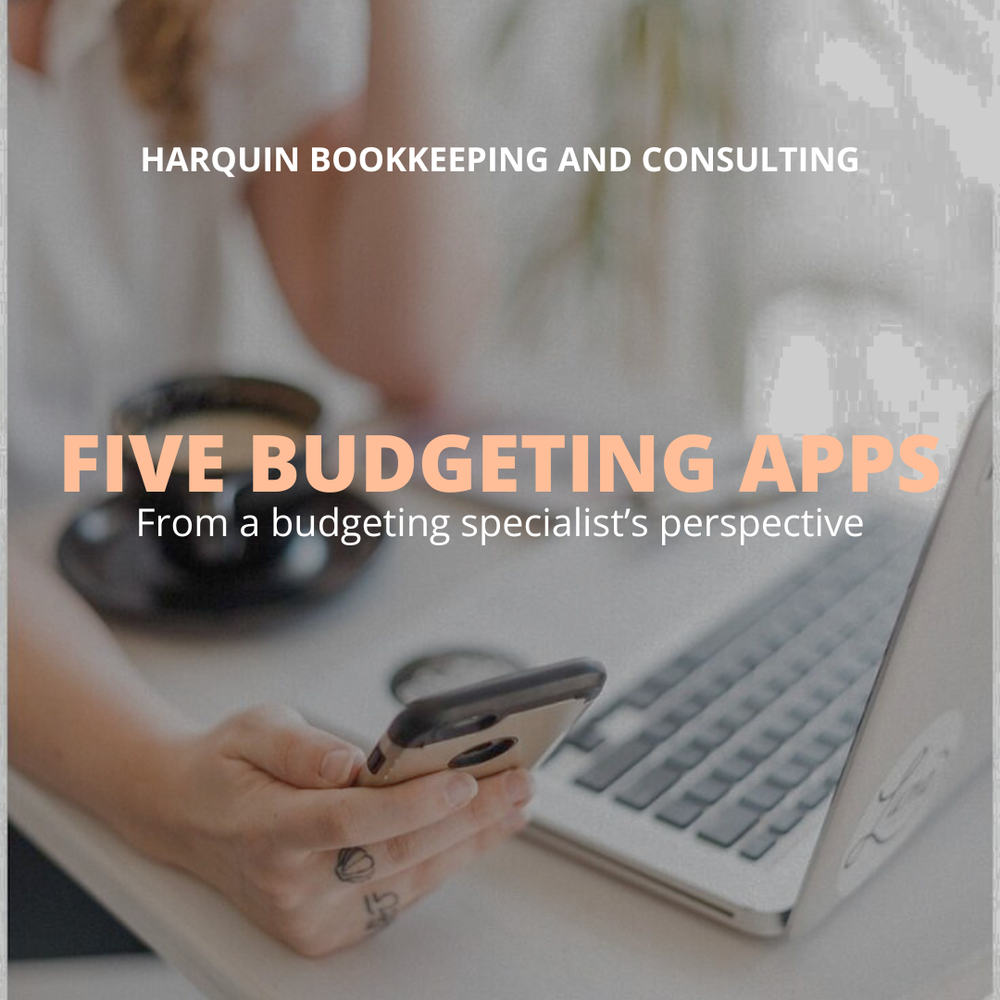Five Budgeting Apps: From a Budgeting Specialist's Perspective
In an age where every dollar counts, mastering budgeting is the key to financial empowerment. With a plethora of budgeting apps vying for your attention, the challenge lies in finding the right tool to suit your needs. Yet, beneath the surface lies a deeper truth: budgeting isn't merely about tracking expenses – it's about sculpting a secure financial future. Here is a list of comparable budgeting apps based on different budget methods or needs to help you along your way in your budgeting journey.
Zero-Based Budgeting Method
The zero-based budget method involves deducting expenses from income to arrive at a zero balance. This is best for individuals with a steady income and some budgeting experience. However, it can be time-consuming and requires adjusting spending categories when one is exceeded, potentially throwing off the budget if a large expense is forgotten. Here are a couple Zero-Based budgeting apps to consider.
YNAB
YNAB, short for You Need a Budget, is more than just a budgeting app—it's a transformative financial tool that empowers users to take control of their money with precision and intentionality. When you receive your paycheck, YNAB prompts you to allocate your income across various categories, such as spending, savings, and debt repayment. This proactive approach encourages users to actively engage with their finances, fostering a deeper understanding of where their money goes and how it can best serve their financial goals.
One of the key features of YNAB is its ability to seamlessly link your checking and savings accounts, as well as credit cards and loans, providing a comprehensive view of your financial landscape across multiple devices, including smartphones, desktops, iPads, Apple Watches, and even through voice commands with Alexa integration.
The philosophy behind YNAB is rooted in four fundamental principles. First, it employs the zero-based budgeting method, where every dollar has a job, ensuring that no money is left unallocated. Second, it encourages users to embrace their true expenses by setting aside money each month for larger, less frequent expenses, thereby avoiding financial strain when these expenses arise. Third, YNAB promotes flexibility through its "roll with the punches" approach, allowing users to adjust their budgets and reallocate funds as needed to accommodate changes in their financial circumstances. Finally, YNAB encourages users to "age" their money by saving up a full month of income, enabling them to cover current expenses with money earned in the previous month, thereby breaking the paycheck-to-paycheck cycle and building financial stability.
While YNAB offers unparalleled functionality and transformative potential, it's important to note that it requires a commitment to active engagement with your finances. This hands-on approach may not be suitable for everyone, especially those who prefer a more passive approach to budgeting. Additionally, the price of YNAB may be a deterrent for some users, as it comes with a subscription fee of $14.99 per month or $99 per year. However, YNAB offers a free 34-day trial for users to test out its features before committing, and college students can access YNAB for free for a year, making it accessible to a wide range of users seeking to take control of their finances and achieve their financial goals.
EveryDollar
EveryDollar, a budgeting app designed to simplify financial management, offers both a free and premium version to cater to diverse user needs. Let's explore the features and considerations associated with each.
The free version of EveryDollar operates on the zero-based budgeting method, ensuring that every dollar is assigned a purpose. As you allocate funds, the app dynamically adjusts, displaying "It's an EveryDollar budget" when your budget reaches zero. If discrepancies arise, EveryDollar provides real-time feedback, indicating the remaining amount to be budgeted or highlighting overspending. While the free version does not sync with bank accounts, users manually input income and expenses, categorize transactions, and set bill payment reminders, fostering hands-on interaction with finances.
For those seeking enhanced automation and convenience, the premium version of EveryDollar offers expanded features. With bank account connectivity, transactions seamlessly populate within the app, streamlining budget tracking. Additionally, the premium version provides custom reports and personalized recommendations based on spending habits, empowering users with deeper insights into their financial behaviors. Moreover, users can integrate saving and investing accounts, ensuring a holistic view of their financial landscape.
Despite its benefits, potential users should consider a few drawbacks. The free version of EveryDollar offers limited functionality, requiring manual transaction entry and lacking automated categorization. Transitioning to the premium version comes at a cost, with subscription fees of $79.99 annually or $17.99 monthly.
50/30/20 Budgeting method
50/30/20 Budgeting method: the 50/30/20 budget breaks expenses into necessary expenses (50%), discretionary expenses (30%), and savings/debt payments (20%). This method is less time-consuming and suitable for those new to budgeting but may be harder for individuals with significant debt or large savings goals but not impossible.
NerdWallet
At its core, the NerdWallet app provides users with a panoramic view of their financial landscape. By seamlessly connecting to a diverse range of financial accounts, including income, spending, net worth, and even home values, users gain a holistic understanding of their financial health. The cash flow feature facilitates real-time tracking of incoming and outgoing funds, enabling users to compare their financial activity over different time periods, whether it's weekly, monthly, or annually.
One of the app's standout features is its robust budgeting functionality. Utilizing the widely recognized 50/30/20 budgeting guidelines, NerdWallet categorizes expenses into needs, wants, savings, and debt, offering users clear insights into their spending habits and financial priorities. This structured approach empowers users to make informed decisions about their finances and align their spending with their long-term goals.
Moreover, NerdWallet goes beyond basic budgeting by providing users with access to additional financial resources and tools. Users can access their free credit score and report directly within the app, empowering them to monitor their credit health and take proactive steps to improve it. Additionally, NerdWallet is introducing a financial health score, allowing users to assess their readiness to navigate financial challenges and achieve their aspirations.
Educational resources are also a cornerstone of the NerdWallet app, offering users a wealth of articles, insights, and product reviews to enhance their financial literacy and decision-making. Whether users are seeking guidance on saving strategies, investment options, or navigating financial products, NerdWallet's comprehensive resources provide valuable support every step of the way.
In summary, the NerdWallet app stands out as a versatile and user-friendly tool for financial management. With its broad range of features, including comprehensive account connectivity, budgeting guidance, credit monitoring, and educational resources, NerdWallet empowers users to take control of their financial future and make informed decisions to achieve their financial goals. And it’s all free.
pocketguard
PocketGuard, though not the most feature-rich app on the market, stands out for its commitment to simplicity—a quality we appreciate. By streamlining financial management, PocketGuard offers users a straightforward approach to budgeting and tracking expenses.
One of PocketGuard's primary features is its ability to connect to various financial accounts, including bank accounts, credit cards, loans, and investments, allowing users to gain a comprehensive view of their financial landscape. With this information, PocketGuard calculates how much discretionary income users have left after allocating funds for necessities, bills, and goals, providing valuable insights into spending habits and financial priorities.
A standout feature of PocketGuard is its personalized debt payoff plan, which analyzes users' debt balances and interest rates to devise an effective repayment strategy. By creating a repayment schedule tailored to individual financial circumstances, PocketGuard empowers users to take control of their debt and work towards financial freedom.
Moreover, PocketGuard tracks users' net worth and offers the flexibility to manually track finances for those who prefer not to link their accounts. The paid version, PocketGuard Plus, provides additional features such as enhanced debt payoff planning and transaction exporting capabilities.
PocketGuard's main focus is on showing users how much discretionary income they have available, aptly termed as "in my pocket," to prevent overspending and promote mindful financial decisions. With its hands-off approach, PocketGuard encourages users to interact with the app primarily to monitor their discretionary spending, offering convenience for those seeking a largely automated experience.
However, users considering PocketGuard should be aware that its simplicity may come at the cost of detailed financial planning capabilities. While the app effectively manages finances for a hands-off experience, it may not be ideal for users who prefer a more proactive approach to financial planning.
In terms of cost, PocketGuard offers a free basic version, while PocketGuard Plus is available for $12.99 per month or $74.99 per year, providing access to additional features and functionality.
Love budgeting but like using spreadsheets?
tiller
Tiller stands out as a top choice. One of Tiller's standout features is its seamless integration with Google Sheets or Microsoft Excel, allowing users to connect their financial accounts, including banks, credit cards, and investments, directly to these familiar spreadsheet platforms. This integration offers a wealth of tools and customization options, empowering users to analyze everything from their monthly budget to business expenses with ease.
The recent addition of the Debt Payoff Planner further enhances Tiller's utility, simplifying debt tracking and repayment. This feature provides a comprehensive overview of users' debt obligations, including current balances, interest rates, minimum monthly payments, and progress towards debt payoff goals. Users can visualize their debt payoff journey, with insights into projected payoff dates, total interest paid, and recommended payments to achieve desired goals.
For those concerned about the time investment required for spreadsheet management, Tiller offers a convenient solution. Users can opt to receive a daily email summary of their most recent transactions and balances, eliminating the need for manual spreadsheet updates while staying informed about their financial status.
Tiller's pricing structure is transparent and accessible, with a 30-day free trial followed by an annual subscription fee of $79. This subscription unlocks the full range of Tiller's features and ongoing support.
In summary, Tiller excels as a budgeting app for users seeking in-depth financial analysis and customization capabilities. With its seamless spreadsheet integration, powerful debt tracking tools, and optional email summaries, Tiller empowers users to take control of their finances and achieve their financial goals with confidence.
Conclusion
Each of these budgeting apps, whether free or paid, offers a unique set of features and functionalities to suit diverse financial needs and preferences. Whether you prefer a hands-on approach or automated assistance, rest assured there's an option tailored to help you take control of your finances and realize your financial aspirations.
If you would like to get more support, we offer Budgeting Consulting with different levels of working together to help you find a budget you’ll actually use so you can increase profit and freedom in your life. Learn more here!
References:
Cruze, R. (2024, February 13). Budgeting Apps Comparison 2024. Ramsey Solutions. https://www.ramseysolutions.com/budgeting/budgeting-apps-comparison
The 10 best budgeting apps for 2024. (2024, February 23). Fortune Recommends. https://fortune.com/recommends/banking/best-budgeting-apps/#pocketguard
Ayoola, E. (2024, February 22). The best budget apps for 2024. NerdWallet. https://www.nerdwallet.com/article/finance/best-budget-apps
Schwahn, L. (2024, February 23). Mint Alternatives: NerdWallet and other free budgeting apps. NerdWallet. https://www.nerdwallet.com/article/finance/nerdwallet-vs-mint-free-budgeting-apps
Berger, R. (2024, March 1). 10 Best Mint Alternatives for 2024 (Free & Paid) – RobBerger.com. RobBerger.com. https://robberger.com/mint-alternatives/?gbraid=0AAAAABbR07s3y2d-rsD-X2WDzKicYn7FT&gclid=CjwKCAiA_5WvBhBAEiwAZtCU78LZ4u5o7x4exPg9TBgneOo4O_75r99qdTJiniMYIVTTN-T3L3-vtRoCiJ8QAvD_BwE

